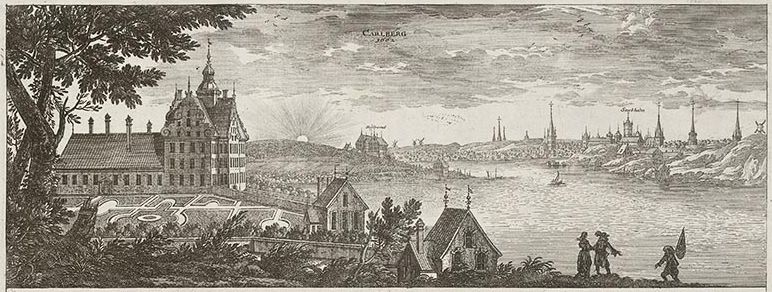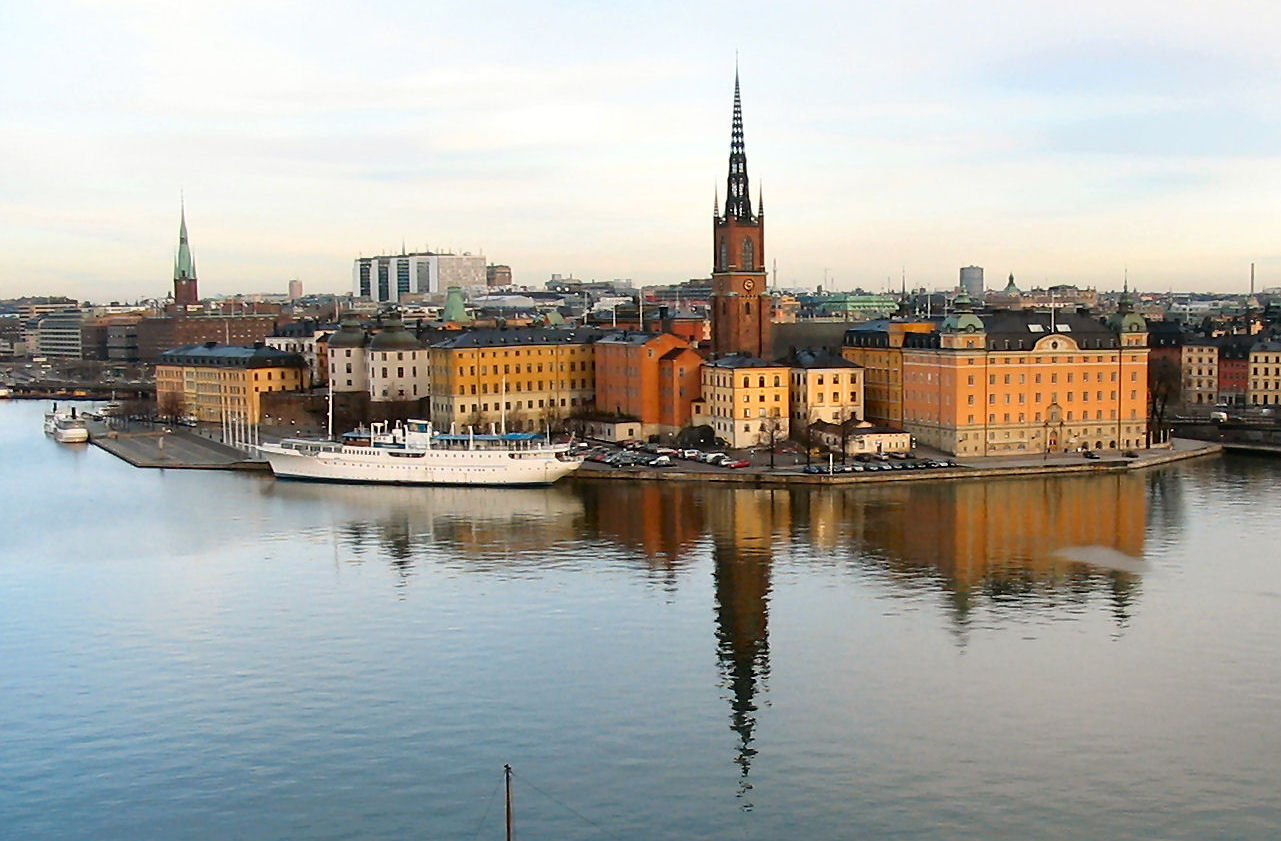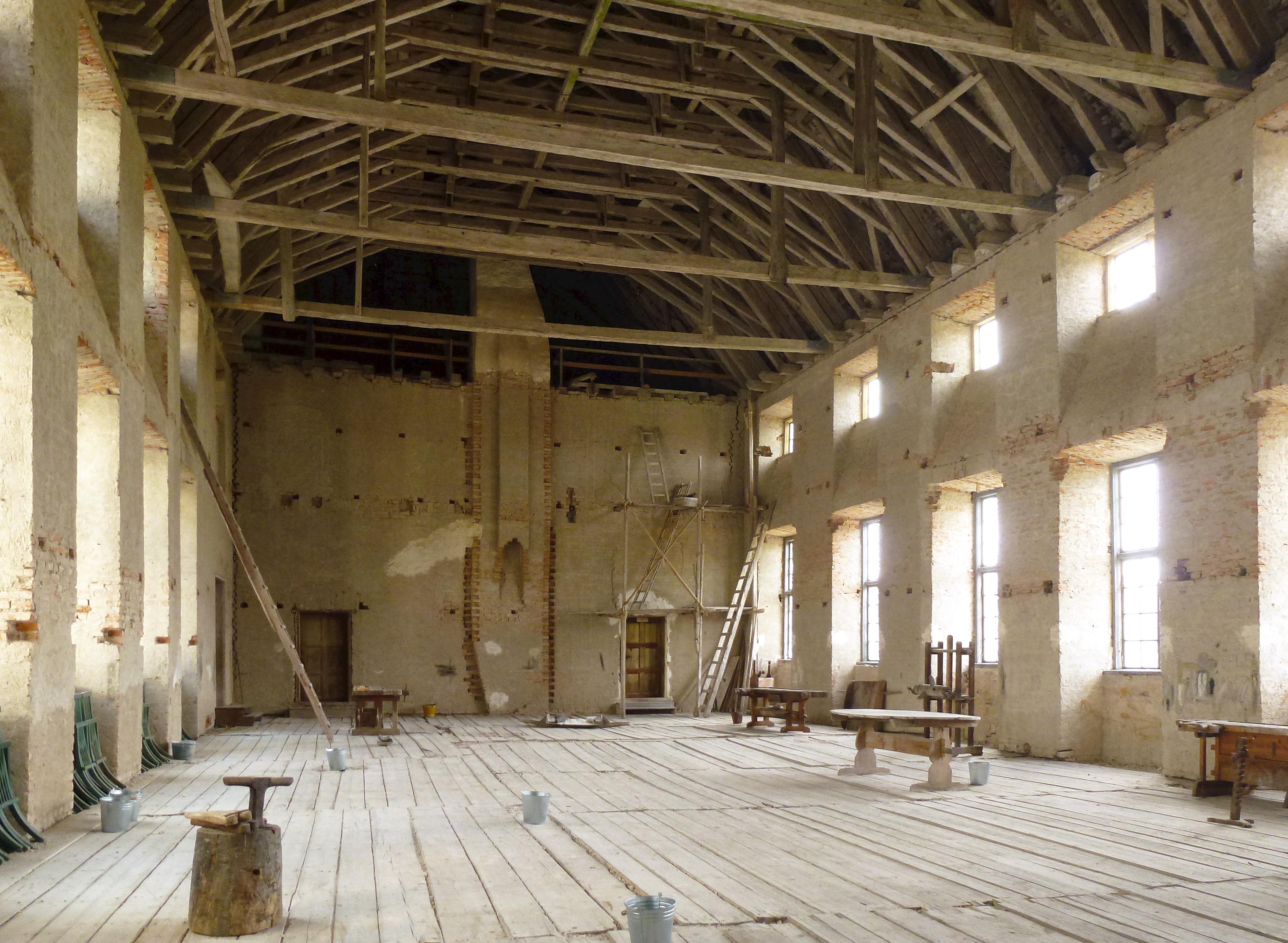|
Jean De La Vallée
Jean de la Vallée (ca 1620 – 12 March 1696) was a Swedish architect. Biography Born in France, he was the son of architect Simon de la Vallée (ca 1595–1642). He made early trips in France and Italy where he studied the new baroque forms of architecture. In 1637, he came to Sweden with his father Simon who was killed by a Swedish nobleman in 1642. The father had started the planning of the House of Knights in Stockholm, and in 1660 his son finished his father's work. Prior to this, Jean de la Vallée had planned two major churches in central Stockholm, Katarina kyrka in 1656 and Hedvig Eleonora Church in 1658. In 1646, he received a royal scholarship for three years and began an international trip to study architecture. The journey went over the Netherlands to Paris where he arrived in August 1646. It continued to Italy and Rome, which he first left in the spring of 1650. He also worked on the commission of many noblemen. For Magnus Gabriel de la Gardie he planned ... [...More Info...] [...Related Items...] OR: [Wikipedia] [Google] [Baidu] |
Architect
An architect is a person who plans, designs and oversees the construction of buildings. To practice architecture means to provide services in connection with the design of buildings and the space within the site surrounding the buildings that have human occupancy or use as their principal purpose. Etymologically, the term architect derives from the Latin ''architectus'', which derives from the Greek (''arkhi-'', chief + ''tekton'', builder), i.e., chief builder. The professional requirements for architects vary from place to place. An architect's decisions affect public safety, and thus the architect must undergo specialized training consisting of advanced education and a ''practicum'' (or internship) for practical experience to earn a Occupational licensing, license to practice architecture. Practical, technical, and academic requirements for becoming an architect vary by jurisdiction, though the formal study of architecture in academic institutions has played a pivotal role in ... [...More Info...] [...Related Items...] OR: [Wikipedia] [Google] [Baidu] |
Karlberg Castle
Karlberg Palace () is a palace by the Karlberg Canal in Solna Municipality in Sweden, adjacent to Stockholm's Vasastaden district. The palace, built in 1630,Solna: Huvudsta today houses the Military Academy Karlberg. In the palace park are found, among other things, a "temple of Diana" (originally dedicated to Neptune) and the burial site of ''Pompe'', the dog of King Charles XII. Notwithstanding that the palace remains a military institution, the palace park is accessible to the public and is open daily between 6 AM and 10 PM.Solna: Karlbergsparken History Gyllenhielm Three medieval villages at the location — Ösby, Bolstomta, and Lundby — were bought by Lord High Admiral Carl Carlsson Gyllenhielm (1574-1650) in the 1620s and subsequently unified into a single estate named "Karlberg" after himself. He then had master mason Hans Drisell build a Renaissance palace featuring pink plaster and tall gables.Solna: Karlberg As Gyllenhielm's widow died six years a ... [...More Info...] [...Related Items...] OR: [Wikipedia] [Google] [Baidu] |
1696 Deaths
Events January–March * January 21 – The Recoinage Act, passed by the Parliament of England to pull counterfeit silver coins out of circulation, becomes law.James E. Thorold Rogers, ''The First Nine Years of the Bank of England'' (Clarendon Press, 1887 p. 41 * January 27 – In England, the ship HMS ''Royal Sovereign'' (formerly ''HMS Sovereign of the Seas'', 1638) catches fire and burns at Chatham, after 57 years of service. * January 31 – In the Netherlands, undertakers revolt after funeral reforms in Amsterdam. * January – Colley Cibber's play ''Love's Last Shift'' is first performed in London. * February 8 (January 29 old style) – Peter the Great who had jointly reigned since 1682 with his mentally-ill older half-brother, Tsar Ivan V, becomes the sole Tsar of Russia when Ivan dies at the age of 29. * February 15 – A plot to ambush and assassinate King William III of England in order to restore King James and the House of Stuar ... [...More Info...] [...Related Items...] OR: [Wikipedia] [Google] [Baidu] |
1620 Births
Sixteen or 16 may refer to: *16 (number), the natural number following 15 and preceding 17 *one of the years 16 BC, AD 16, 1916, 2016 Films * '' Pathinaaru'' or ''Sixteen'', a 2010 Tamil film * ''Sixteen'' (1943 film), a 1943 Argentine film directed by Carlos Hugo Christensen * ''Sixteen'' (2013 Indian film), a 2013 Hindi film * ''Sixteen'' (2013 British film), a 2013 British film by director Rob Brown Music *The Sixteen, an English choir *16 (band), a sludge metal band * Sixteen (Polish band), a Polish band Albums * ''16'' (Robin album), a 2014 album by Robin * 16 (Madhouse album), a 1987 album by Madhouse * ''Sixteen'' (album), a 1983 album by Stacy Lattisaw *''Sixteen'' , a 2005 album by Shook Ones * ''16'', a 2020 album by Wejdene Songs * "16" (Sneaky Sound System song), 2009 * "Sixteen" (Thomas Rhett song), 2017 * "Sixteen" (Ellie Goulding song), 2019 *"16", by Craig David from ''Following My Intuition'', 2016 *"16", by Green Day from ''39/Smooth'', 1990 *"16", by ... [...More Info...] [...Related Items...] OR: [Wikipedia] [Google] [Baidu] |
Mathias Spieler
Mathias Spihler (c. 1640 – February 1691) was a Swedish architect and master builder of German descent. Biography Spihler was born at Södermalm in Stockholm, Sweden. He aided Jean de la Vallée in the design and construction of Katarina Kyrka (Catherine Church) as technical superintendent at the church in 1671. Spihler also built the Van der Nootska Palace between 1671 and 1672. In the latter half of the 17th century, Marshal of the Realm of Sweden Johan Gabriel Stenbock (1640-1705) brought the Sjööe state in the parish of Holm in Enköping. Together with Mathias Spieler and architect Nicodemus Tessin the Elder Nicodemus Tessin the Elder () (7 December 1615 in Stralsund – 24 May 1681 in Stockholm) was an important Swedish architect. Biography Nicodemus Tessin was born in Stralsund in Pomerania and came to Sweden as a young man. There he met and wor ... (1615-1681), Stenbock built Sjöö Castle on his estate. The construction work lasted from 1669 until 16 ... [...More Info...] [...Related Items...] OR: [Wikipedia] [Google] [Baidu] |
Riddarholmen
Riddarholmen (, "The Knights' Islet") is a small islet in central Stockholm, Sweden. The island forms part of Gamla Stan, the old town, and houses a number of private palaces dating back to the 17th century. The main landmark is the church Riddarholmskyrkan, used as Sweden's royal burial church from the 17th century to 1950, and where a number of earlier Swedish monarchs also lie buried. The western end of the island gives a magnificent panoramic and photogenic view of the bay Riddarfjärden, often used by TV journalists with Stockholm City Hall in the background. A statue of Birger Jarl, traditionally considered the founder of Stockholm, stands on a pillar in front of the Bonde Palace, north of Riddarholm Church. Other notable buildings include the Old Parliament Building in the south-eastern corner, the Old National Archive on the eastern shore, and the Norstedt Building, the old printing house of the publisher Norstedts, the tower roof of which is a well-known silhouette on ... [...More Info...] [...Related Items...] OR: [Wikipedia] [Google] [Baidu] |
Wrangel Palace
Wrangel Palace () is a townhouse mansion on Riddarholmen islet in Gamla Stan, the old town of Stockholm, in Sweden. Courthouse Since 1756 the palace has housed Svea Court of Appeal (''Svea Hovrätt''), the regional court of appeal. History Wrangel Palace has a long history. The southern tower used to be part of Gustav Vasa's defence fortifications from the 1530s. 17th century Around 1630, the mansion was turned into a palace for Lars Sparre. From 1652 to 1670, the palace was rebuilt and expanded by architect Nicodemus Tessin the Elder for Count Carl Gustaf Wrangel. After a fire in 1693, the palace was rebuilt and expanded once again, this time to become a royal residence after the devastating fire that left the Tre Kronor Castle in ruins (1697). Royal palace Wrangel Palace was the official Stockholm residence of the royal family and court from 1697 until 1754, when the Royal Palace of Stockholm was completed. During this time, the Palace was called ''Kungshuset'' (The Kings Hou ... [...More Info...] [...Related Items...] OR: [Wikipedia] [Google] [Baidu] |
Supreme Court Of Sweden
The Supreme Court of Sweden ( sv, Högsta domstolen, abbreviated ''HD'') is the supreme court and the third and final instance in all civil and criminal cases in Sweden. Before a case can be decided by the Supreme Court, leave to appeal must be obtained, and with few exceptions, leave to appeal can be granted only when the case is of interest as a precedent. The Supreme Court consists of 16 Justices ( sv, justitieråd) who are appointed by the government, but the court as an institution is independent of the Riksdag, and the Government is not able to interfere with the decisions of the court. History Historically, all judicial power was vested in the Monarch, but in 1614 Gustavus Adolphus instituted Svea Hovrätt and authorized it to issue sentences in his name. Those not satisfied with sentencing were able to turn directly to the monarch, and appeals were handled by the Justice Department of the Privy Council (in sv, Justitierevisionen), a committee of that council. Und ... [...More Info...] [...Related Items...] OR: [Wikipedia] [Google] [Baidu] |
Palace Of Bonde
The Bonde Palace ( sv, Bondeska palatset) is a palace in Gamla stan, the old town in central Stockholm, Sweden. Located between the House of Knights (''Riddarhuset'') and the Chancellery House (''Kanslihuset''), it is, arguably, the most prominent monument of the era of the Swedish Empire (1611–1718), originally designed by Nicodemus Tessin the Elder and Jean De la Vallée in 1662-1667 as the private residence of the Lord High Treasurer Gustaf Bonde (1620–1667) it still bears his name, while it accommodated the Stockholm Court House from the 18th century and since 1949 houses the Swedish Supreme Court. On the south side of the building is the street Myntgatan and the square Riddarhustorget, while the alleys Riddarhusgränd and Rådhusgränd are passing on its western and eastern sides. History The original design by Simon de la Vallée and Tessin the Younger, based on French Baroque and Renaissance prototypes, was H-shaped in plan, the planned two southern wings flanking a ... [...More Info...] [...Related Items...] OR: [Wikipedia] [Google] [Baidu] |
Castle Of Skokloster
Skokloster Castle ( sv, Skoklosters slott) is a Swedish Baroque castle built between 1654 and 1676 by Carl Gustaf Wrangel, located on a peninsula of Lake Mälaren between Stockholm and Uppsala. It became a state museum in the 1970s and displays collections of paintings, furniture, textiles and tableware as well as books and weapons that amount to 20,000 items. History The castle was built in the Baroque style between 1654 and 1676 by the wealthy military commander count Carl Gustaf Wrangel on a peninsula of Lake Mälaren between Stockholm and Uppsala. It was designed mainly by architect , and other architects involved were Jean de la Vallée and Nicodemus Tessin the Elder. It is probable, that castle was built based on Ujazdów Castle in Warsaw, Poland. The castle is a monument to the Swedish Age of Greatness, a period in the middle of the 17th century when Sweden expanded to become one of the major powers in Europe. The death of Wrangel in 1676 meant that the castle was never ... [...More Info...] [...Related Items...] OR: [Wikipedia] [Google] [Baidu] |
Simon De La Vallée
Simon de la Vallée (1590–1642) was a French-Swedish architect. The first architect in Sweden to have received formal academic training, he created the Swedish school of architecture. Biography Born in Paris, he was the son of Marin de la Vallée (1576–1655), an architect associated with the Paris Hôtel de Ville and the Luxembourg Palace. After studying under Salomon de Brosse (1571–1626), he spent the next eight years on several study trips, travelling in particular to Italy, Syria, Jerusalem and Persia. After returning to Paris in 1633, he was charged by Prince Frederick Henry of Orange to undertake work on the Honselaarsdijk Palace in the Netherlands."Simon de la Vallée" ''Historiesajten.se''. Retrieved 2 May 2012. In 1637, he was invited to Stockholm by Field Marshal [...More Info...] [...Related Items...] OR: [Wikipedia] [Google] [Baidu] |






